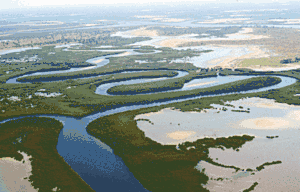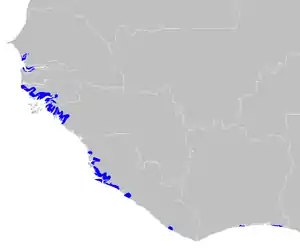Guinean mangroves
The Guinean mangroves are a coastal ecoregion of mangrove swamps in rivers and estuaries near the ocean of West Africa from Senegal to Sierra Leone.
| Guinean mangroves | |
|---|---|
 mangroves in the Sine-Saloum Delta, Senegal | |
 Map of the Guinean mangroves | |
| Ecology | |
| Realm | Afrotropical |
| Biome | mangrove |
| Borders | Eastern Guinean forests, Guinean forest-savanna mosaic, and Western Guinean lowland forests |
| Geography | |
| Area | 22,165 km2 (8,558 sq mi) |
| Countries | |
| Conservation | |
| Conservation status | Vulnerable |
| Protected | 5,289 km² (24%)[1] |

Location and description
Guinean mangroves can be found: in the Saloum River and Casamance deltas in Senegal; in the lower Gambia River basin; much of the coast of Guinea-Bissau, including the Cacheu and Mansoa Rivers; across the border in northern Guinea; and much of the coast of Sierra Leone including the Sherbro River. Mangroves thrive on flat coastal inlets and estuaries where the ocean tides wash warm salt water high upriver, in this ecoregion as far as 100 km, for example in the Cacheu River of Guinea-Bissau.[2][3]
Flora
The mangroves have a varied composition with Rhizophora, Laguncularia racemosa and Conocarpus erectus growing up to 10m tall among larger areas of Rhizophora and Avicennia. The tallest trees may be 40 m (130 ft) and form the equivalent of gallery forests along the creeks, the mudflats between the creeks having much shorter trees. The inland fringes of the forest are clad in grasses, ferns and salt-loving plants.[3] However, the flora in the ecoregion is not as biodiverse as that of East African mangrove forests.[2]
Fauna
Mangrove swamps are important feeding grounds for fish, birds and animals. Marine wildlife includes oysters and shrimps. Mammals found here include the African manatee. Birds in these wet habitats include Goliath heron, purple heron, cattle egret, striated heron, western reef heron, greater flamingo, lesser flamingo, African spoonbill, and African sacred ibis.[3] The forests also provide important habitat for migratory birds.[2]
Threats and preservation
Mangrove habitats are under threat as trees are cut down for timber and firewood or to clear land for agriculture including rice farming. This habitat is also under threat from the lower amounts of precipitation in the region over the last few decades.[2] In southern Senegal, efforts are being made to replant the mangroves.[4] Urban areas near the mangroves include the Gambian capital, Banjul and the Guinea-Bissau capital Bissau. National parks in the region include Saloum Delta National Park and Basse Casamance National Park in Senegal, Niumi National Park in Gambia, and Tarafes de Cacheu Natural Park in Guinea-Bissau. The Saloum river delta can also be accessed from the village of Foundiougne in Senegal.[5]
References
- Eric Dinerstein, David Olson, et al. (2017). An Ecoregion-Based Approach to Protecting Half the Terrestrial Realm, BioScience, Volume 67, Issue 6, June 2017, Pages 534–545; Supplemental material 2 table S1b.
- "Guinean mangroves". Terrestrial Ecoregions. World Wildlife Fund.
- "Sierra Leone". Status And Trends In Mangrove Area Extent Worldwide. FAO. Retrieved 27 November 2016.
- "Senegal: Protecting livelihoods through mangroves". IRIN Africa. 14 October 2008. Retrieved 27 November 2016.
- "Senegal's mangrove forests" (PDF). Country report. Retrieved 27 November 2016.